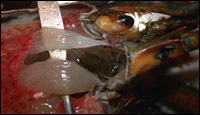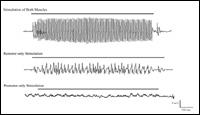Sound Production
 Figure 1 |
 Figure 2 |
 Figure 3
|
 Figure 4 |
 Figure 5
|
 Figure 6
|
 Figure 7 |
 Figure 8
|
To investigate sound production in lobsters we performed 4 experiments (click on images to enlarge):
1. Body vibration production surveys
A total of 1622 legal sized lobsters were surveyed at the Little Bay Lobster Co. in Newington NH, between October 2003 and September 2004 to determine which size classes and sexes produce body vibrations when grasped. 101 sublegal and small legal lobsters caught in UNH traps deployed in inshore waters off of Newcastle Island, New Hampshire were surveyed in the summer months of 2003 and 2004. In both surveys, lobsters were grasped around their dorsal carapace and lifted three times. The presence or absence of a body vibration, size and sex were recorded.
2. Recording and characterization of body vibrations and sounds
In the lab, sounds were recorded from known sound producing lobsters and characterized according to their frequency and duration. Acoustic signals were recorded by two means: 1) by measuring vibrations of the carapace using an accelerometer glued to the carapace and; 2) by recording the associated waterborne acoustic component of sound production with a hydrophone placed near the lobster. We found that lobsters produce body vibrations and waterborne sounds simultaneously and they both have an average frequency of 183 Hz, suggesting that both signals are created by the same mechanism. Individual lobsters were found to produce acoustic signals in a wide range of frequencies (87-261 Hz) and duration (279.2 ms). All lobsters produced sounds similar in frequency, intensity and duration.
3. Electromyograms of putative sound producing muscles
To determine if the remotor muscle was the source of lobster sounds electrical activity of the remotor muscle and its antagonist, the promotor muscle, were recorded during sound production. The remotor and promotor muscles are located at the base of the antennae and serve to move the antennae up and down. They are antagonist muscles, such as our triceps and biceps, with one muscle responsible for upward movement and the other for downward movement.
Both the remotor and promotor muscle contract during sound production events, such that there is one contraction for each pulse of sound. Most often only one set of muscles (i.e the left or right remotor and promotor) was active during sounds (90% of the time), while on limited occasions both sets of muscles were active during sounds (10%)
4. Lesions and stimulations of muscles
Although we found that the remotor and promotor are active during sound production, we could not say for sure that the contraction of these muscles caused the sounds. To figure this out we performed lesions of the muscles and manual stimulations to see if 1) lobsters could produce sounds without the muscles and 2) if we could induce sounds by stimulating the muscles. Our results suggest that while both muscles are active during sound production, the larger remotor is more important to sound production, while the promotor seems to play a yet to be determined modulatory function.
